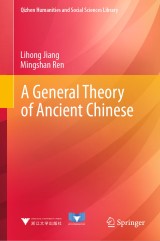Details

A General Theory of Ancient Chinese
Qizhen Humanities and Social Sciences Library
|
128,39 € |
|
| Verlag: | Springer |
| Format: | |
| Veröffentl.: | 20.03.2023 |
| ISBN/EAN: | 9789811660429 |
| Sprache: | englisch |
| Anzahl Seiten: | 490 |
Dieses eBook enthält ein Wasserzeichen.
Beschreibungen
<div>This book systematically outlines the development of ancient Chinese. Consisting of 20 chapters, the self-contained work presents macro-level discussions on a broad range of topics, including: philology, phonology, exegetics, certain words’ special meanings, sentence types, the flexible use of words, different grammars in ancient and modern times, and rhetoric. </div><div><br></div><div>Though chiefly focusing on vocabulary, the book also addresses grammar, and points out grammar problems that differ considerably from those in modern Chinese, in addition to combining morphology and syntax. Further, unlike the majority of textbooks on the subject, it pays more attention to the rhetoric used in ancient Chinese literary works. Rather than simply analyzing linguistic phenomena, the book also (and more importantly) provides a meaningful approach to the study of ancient Chinese. Accordingly, it offers a valuable asset for researchers, graduate students, and everyone else who is interested in ancient Chinese.</div>
<div>Chapter 1 Preface.- Chapter 2 Overview of the Form and Meaning of Character, Dictionary.- Chapter 3 Exegetic theory of “Sound and Note Reflect Meaning” and “Similar Sound and Note, Similar Meaning”.- Chapter 4 Explanation of the Meaning of Words.- Chapter 5 Sentences.- Chapter 6 Judgement Sentences and Declarative Sentences.- Chapter 7 Flexible Use of Words.- Chapter 8 Auxiliary Words and Affix.- Chapter 9 Personal Pronoun and Demonstrative Pronouns.- Chapter 10 Omission and Word Order.- Chapter 11 Declarative Sentences, Exclamatory Sentences, Interrogative Sentences and Imperative Sentences.- Chapter 12 Quantity and Comparison.- Chapter 13 Compound Sentences and Conjunctions.- Chapter 14 Sound, Rhyme and Tone.- Chapter 15 Rhyming Dictionary and Rhyme Classes.- Chapter 16 Old Chinese phonology.- Chapter 17 Rhyme.- Chapter 18 Rhetoric in Classical Literary Works.- Chapter 19 Common Sense of Bibliography.- Chapter 20 Doubts about Ancient Books.</div><div><br></div>
<div>Lihong Jiang (1916 - 1995) is a prominent linguist and expert on Dunhuang studies and lexicography, former professor and doctoral supervisor at Hangzhou University, vice-chairman of the Language and Literature Society, Institute of Dunhuang and Turfan Studies of China, associate editor of <i>Chinese Dictionary</i>, and an editorial board member and branch editor-in-chief of <i>Cihai</i>.</div><div><br></div><div>Mingshan Ren (1912-1967) is a former professor at Hangzhou University, where he focused on the study and teaching of ancient literature, ancient Chinese and modern Chinese. He is the author of <i>Post-Note of the Catalogue of “Book of Rites”</i> and <i>Overview of the History of Chinese Phonetics</i>.</div>
<div>This book systematically outlines the development of ancient Chinese. Consisting of 20 chapters, the self-contained work presents macro-level discussions on a broad range of topics, including: philology, phonology, exegetics, certain words’ special meanings, sentence types, the flexible use of words, different grammars in ancient and modern times, and rhetoric. </div><div><br></div><div>Though chiefly focusing on vocabulary, the book also addresses grammar, and points out grammar problems that differ considerably from those in modern Chinese, in addition to combining morphology and syntax. Further, unlike the majority of textbooks on the subject, it pays more attention to the rhetoric used in ancient Chinese literary works. Rather than simply analyzing linguistic phenomena, the book also (and more importantly) provides a meaningful approach to the study of ancient Chinese. Accordingly, it offers a valuable asset for researchers, graduate students, and everyone else who is interested in ancient Chinese.</div>
Systematically outlines the development of ancient Chinese Departs from the tradition focusing on Old Chinese, and focuses on Middle Chinese instead Facilitates the transition of academic study from the traditional style to modern style

















